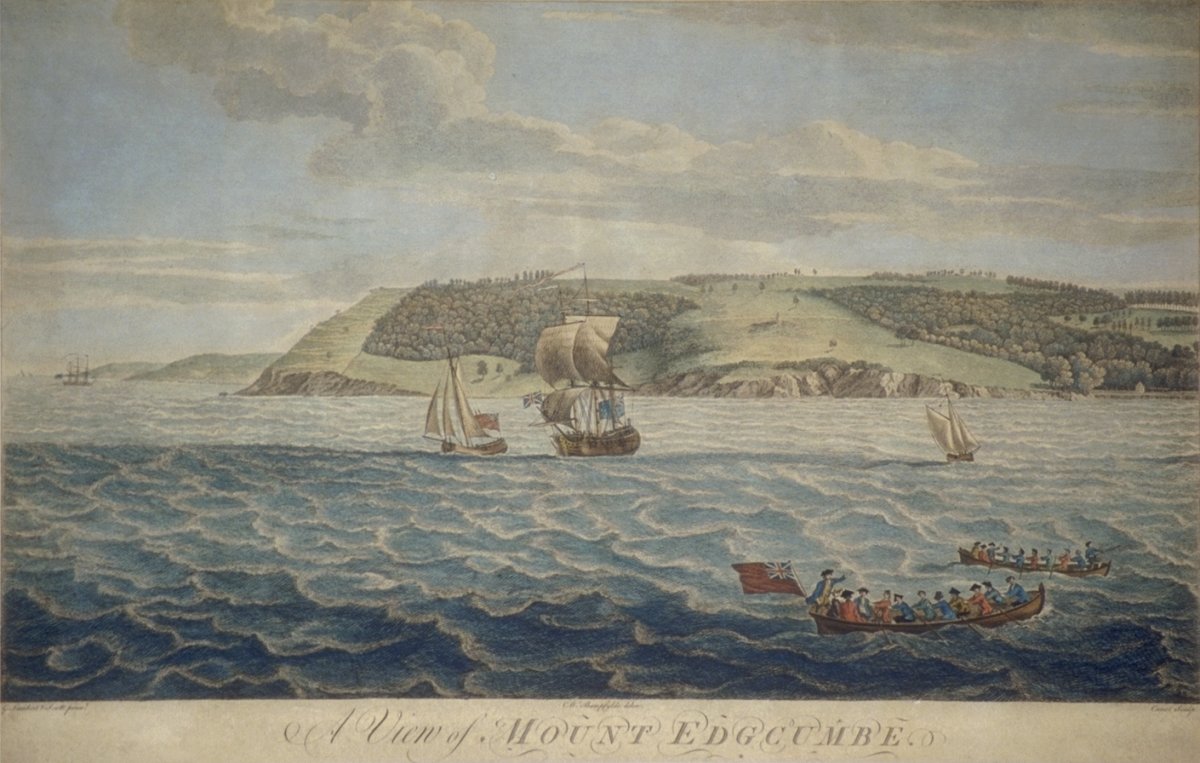A View of Mount Edgcumbe
George Lambert (c.1700 - 1765)
Samuel Scott (c.1702 - 1772)
Coplestone Warre Bampfylde (1720 - 1791)
Pierre Charles Canot (1710 - 1777)
Coloured engraving
1755
-
About the work
- Location
-
Country: UK
City: London
Place: Government Art Collection
-
About the artist
George Lambert, theatre scene and landscape painter, divided his career equally between the two professions. For most of his life he lived in Covent Garden. His early style of the 1720s is similar to that of John Wootton. However, his later classical landscapes earned him the accolade ‘the English Poussin’. Lambert painted the landscape backgrounds for William Hogarth’s paintings ‘The Pool of Bethesda’ and ‘The Good Samaritan’, made for St. Bartholomew’s Hospital (1736-37). In 1761 he was elected chairman of the newly founded Society of Artists of Great Britain. The Society received the Royal Seal on 26th January 1765 and just five days later Lambert died at his home in Covent Garden, leaving his possessions to his servant, Ann Terry.
Samuel Scott, marine and topographical painter, was born in London in c.1702. His early subjects were marine scenes and naval engagements, painted in the style of the van de Veldes. However, following Antonio Canaletto's visit to the capital in 1746, Scott was influenced by the growing popularity of the Venetian artist's views of London and the Thames and devoted himself almost exclusively to this subject. Scott's London views became particularly popular. Unlike other imitators of Canaletto, he avoided the Venetian artist's permanent Venetian blue skies. He settled in the fashionable writers' and artists' village of Twickenham but later moved to Bath, where he died.
Coplestone Warre Bampfylde, amateur topographical draughtsman and caricaturist, was born in Somerset, the son of an MP. He attended St John’s College, Oxford and is believed to have visited Europe on the Grand Tour in the 1740s. After inheriting the family estate in 1750, he began to paint watercolours, which he later exhibited at the Society of British Artists, the Royal Academy and the Free Society in London. A keen amateur painter, Bampfylde conducted several painting tours around England and also occasionally worked as an architect. During his life, Bampfylde’s maintained an interest in garden design and was involved in designs for Stourhead in Wiltshire and for his own home at Hestercombe in Somerset.
Engraver Pierre [Peter] Charles Canot is thought to have been born in France in c.1710; the brother of painter Philippe Canot. He was presumably in London by c.1735, when he produced hunting prints after paintings by John Wootton. A further set of prints, after marine works painted by Peter Monamy, were published in 1746. In 1758 he began a lasting collaboration with marine artist Richard Paton. The outbreak of the Seven Years' War brought commissions for depictions of the many naval engagements. He exhibited 19 works at the Society of Artists from 1760 to 1769 and was elected one of the original associate engravers of the Royal Academy in 1770, exhibiting there until 1776. Canot died at his home in Hampstead Road, in the winter of 1777-78.
-
Explore
- Places
- Subjects
- Materials & Techniques
-
Details
- Artist
-
George Lambert (c.1700 - 1765)
Samuel Scott (c.1702 - 1772)
Coplestone Warre Bampfylde (1720 - 1791)
Pierre Charles Canot (1710 - 1777)
- Title
- A View of Mount Edgcumbe
- Date
- 1755
- Medium
- Coloured engraving
- Dimensions
- height: 36.00 cm, width: 56.50 cm
- Acquisition
- Purchased from Parker Gallery, December 1963
- GAC number
- 6362